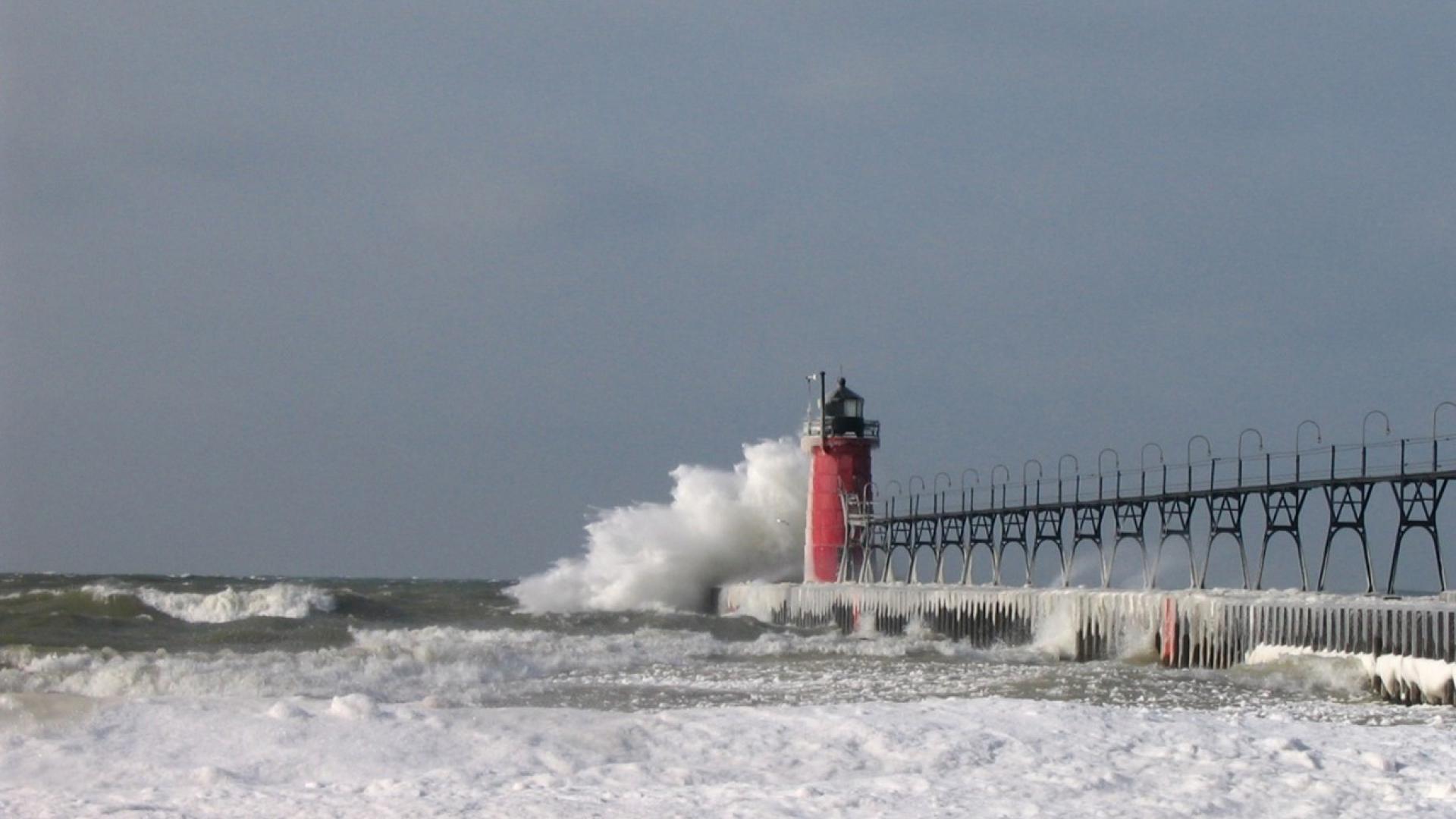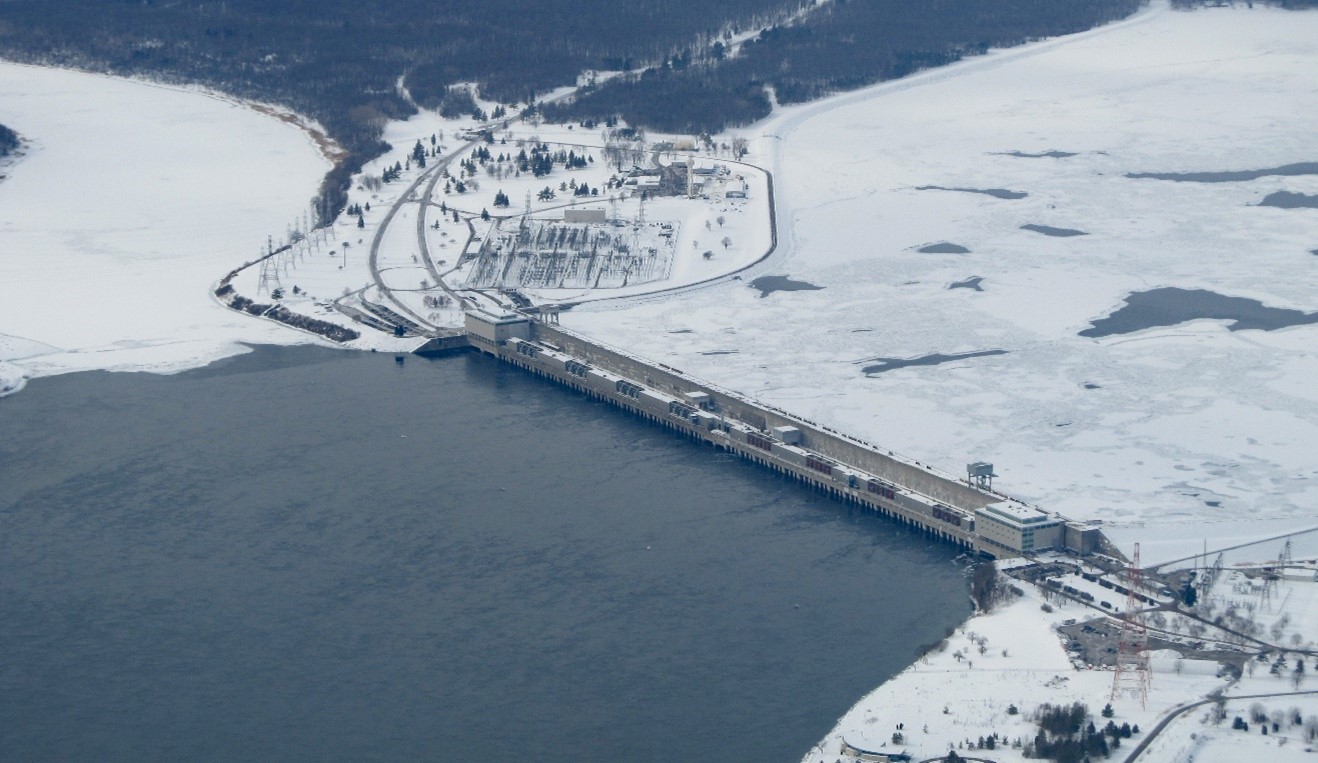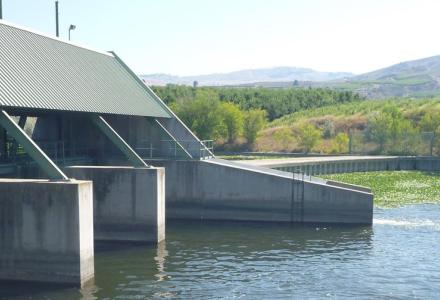
As the global climate changes, so do conditions in the Great Lakes. In coming decades, the Great Lakes are expected to see warmer waters, more frequent and intense storms, less ice cover and greater fluctuations in water levels. The Great Lakes of 2021 are different than they were in 1960 or than they will be in 2050.
The Great Lakes have a cyclical, multi-decade pattern where water levels rise and fall. The levels are primarily dependent on precipitation, inflows from tributaries and evaporation into the atmosphere. Due to the depth of some of the lakes and the size of the Great Lakes watershed, it takes many years for water to flow from the upper lakes down through the St. Lawrence River and into the Atlantic Ocean.
Throughout most of the 2000s until around 2014, drier conditions across the region caused water levels on the lakes to be below average before hitting near-record and record lows. This in turn limited cargo loadings for ships and access to marinas and docks, impacted fish and wildlife habitat and led to discussions about the need for dredging shipping channels.
Beyond 2014, heavy precipitation from severe storms and sizable spring inflows from tributaries (particularly in 2017 and 2019) has led to inverse problems, with the lakes reaching record or near-record high water levels, causing flooding across the basin and damaging homes, marinas, businesses and infrastructure.
Regulation
While there are two major artificial control points within the Great Lakes – the power plants on the St. Marys River and the Moses-Saunders Dam on the St Lawrence River – there are serious physical limits on how much they can do to affect water levels. The structures on the St. Marys and St. Lawrence rivers can only influence water levels by a matter of inches by adjusting outflows and need to take conditions on both sides of the structures into account.

In each case, the Canadian and United States governments have agreed to specific and complex regulation plans (known as Plan 2012 and Plan 2014) that consider all affected interests in managing these flows. But they are not the final word on water conditions in such a massive system. Mother Nature remains in the driver’s seat and ultimately the course we take is up to her.
More extreme water levels and storms have focused public attention across the Great Lakes on how climate change may result in catastrophes. While we do not know what future years will bring, we can project likely scenarios and plan around them.
The IJC has advocated for sustainable shoreline land usage and shoreline protection measures. These include requiring new buildings to be set back from the water, moving or elevating existing properties above flood levels and informing prospective home buyers of the potential flood risk. These recommendations have only become more relevant as intense storms fueled by climate change cause high water levels and erode shorelines. While managing outflows reduces flood risk, effective planning, preparation and implementation by all levels of government are needed to reduce the consequences resulting from extreme highs and lows.
High and low water levels are not the only threat from climate change. Climate change seems to be a true threat multiplier; something that the IJC and its boards have been investigating since the late 1980s. The IJC’s First Triennial Assessment of Progress (TAP) report in 2017 provides a detailed list of climate-related projections and their potential environmental impacts in the Great Lakes region.
Warmer water and extreme storm events in the spring encourage the proliferation of harmful algal blooms in Lake Erie and bays throughout the Great Lakes. Polluted runoff from extreme storms has driven excess nutrients and bacteria into nearshore waters, creating optimal conditions for these organisms to thrive. The extent of cyanobacterial blooms has been captured on satellite images during peak bloom years. These blooms cause dead zones in the central basin of Lake Erie. They also produce deadly cyanotoxins that can be fatal to pets and wildlife, as well as cause liver damage in humans.
Coordination
Given the seriousness and complex nature of climate change impacts on water quantity and quality in the Great Lakes region, all efforts to solve these complicated and interconnected problems need to be coordinated across political and agency jurisdictions.
The IJC and its advisory boards have been advocating for such a coordinated approach for years.
In 2003, the IJC Great Lakes Water Quality Board recommended the two governments develop and implement a climate change adaptation plan for the basin. In 2017, the board outlined steps taken and reiterated the need for a joint regional adaptation plan by the two countries. The board found various communities, state, provincial and federal agencies engaging in aspects of adaptation planning and executing strategies to enhance ecological resilience in the region. Yet, there was no coordinated regional perspective, approach or strategy. The board concluded that a coordinated binational approach was needed to protect Great Lakes water quality in a rapidly changing climate.
Leadership
In its most-recent 2020 Triennial Assessment of Progress Report, the IJC echoed the Water Quality Board finding and urged the governments to demonstrate global leadership by developing a binational approach to climate change adaptation and resilience in the Great Lakes. The IJC has offered to help facilitate collaboration between the governments in advancing work toward developing a coordinated binational strategy.
“We have heard informally from governments that it would be helpful if our earlier recommendation provided greater specificity in terms of next steps,” the report states.
“Therefore, to assist the Parties in advancing work on a coordinated binational strategy, the Commission offers to exercise its convening capacity to identify and further explore essential elements of a binational climate adaptation and resiliency strategy.
“The elements that we shall seek to advance include a shared vision, coordinated action, accountability, information and knowledge, and implementation considerations. We hope this anticipated contribution— which will be completed by late 2022—will facilitate binational dialogue among the Parties and Great Lakes leadership to advance our earlier recommendation.”
Evaluation
Climate adaptation is an important focus of the IJC’s review of the regulation plans that are used to set the outflows from lakes Superior and Ontario. While precipitation, runoff and evaporation drive how water levels in the Great Lakes rise and fall, the IJC is working continuously to optimize the rules for setting the outflows from these two lakes.
The rules are based on studies that took different water supply regimes into account, but the rules may need to be adjusted if future water supplies differ greatly from those that were considered. The IJC appointed a Great Lakes-St. Lawrence River Adaptive Management (GLAM) Committee to monitor how hydroclimate trends as well as socio-economic conditions in the basin may be changing.
Water levels impact different sectors differently and the GLAM is working to improve how those impacts can be predicted in the face of a changing climate.
Each sector has diverse and sometimes conflicting needs. GLAM is working to provide more information and tools to support tradeoff decisions between the needs of commercial navigation, recreational boating and tourism, municipal and industrial water users, hydropower, shoreline property owners, and wetlands in terms of flood protection and ecosystems.

In response to the record floods in 2017 and 2019, the IJC directed the GLAM Committee to undertake an expedited review of Plan 2014, the regulation plan for Lake Ontario outflows, to determine what immediate actions could be taken to reduce the impacts of record-high water supplies in recent years.
As the results of the GLAM Committee’s investigations become available, they are being used to better inform the regulation of Lake Ontario outflows.
The Great Lakes are central to the cultural, economic, ecological and recreational life of the residents of Canada, the United States and the many Indigenous tribes and nations located across the basin. Because climate change is magnifying the effects of other problems across these precious and fragile freshwater resources, the IJC promotes coordinated binational action to safeguard them for future generations.
This article is adapted from another submitted to the Great Lakes/Seaway Review for its March edition.

Rajesh Bejankiwar is a physical sciences officer at the IJC’s Great Lakes Regional Office in Windsor, Ontario.

Kevin Bunch is a writer-communications specialist at the IJC’s US Section office in Washington, D.C.




